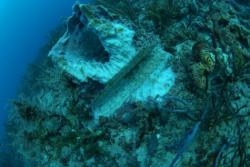http://www.palmbeachdailynews.com/news/content/news/2009/12/26/SUN_reefsand.html
Steve Spring
The town has monitored The Breakers rock pile,
seen here on Nov. 17, 2008, for signs of sand burial
from beach fill projects of 2003 and 2006.
Source of sand on reef off Breakers under investigation
By WILLIAM KELLY
Daily News Staff Writer
Saturday, December 26, 2009
Sand from the 2003 and 2006 Midtown beach fills may have drifted onto nearby shallow reef offshore from The Breakers.
If the state finds the town responsible for the sand cover, it could require it to spend millions of dollars to build artificial reef to mitigate for the damage.
In a Dec. 14 letter to the town, the Florida Department of Environmental Protection rejected the “no impact” conclusion reached by a town consultant that monitored the shallow reef, known as The Breakers rock pile, for signs of sand burial resulting from the beach fills.
In the letter, Dr. Vladimir N. Kosmynin, environmental consultant to the DEP’s Bureau of Beaches and Coastal Systems, noted that the town consultant, Coastal Planning & Engineering, identified extensive sand cover of hard bottom areas in a January 2006 report. In the report, CP&E said it was difficult to determine if the sand came from the Midtown nourishment, hurricanes or “unknown sources of rapidly moving sand.”
Kosmynin wrote that, considering the rapid loss of sand from the beach fill area after nourishments, “it is logical to suggest that the ‘source of rapidly moving sand’ is the beach fill.”
State environmental permits for the Midtown projects required the town to monitor for environmental impacts and report annually to the DEP. Coastal Planning & Engineering performed the work for the town in 2006, 2007 and 2008.
Earlier this year, the town hired two other consultants, Tetra Tech and Coastal Eco-Group, to perform the 2009 monitoring. The DEP has requested that those consultants re-evaluate Coastal Planning & Engineering’s findings in a report due Feb. 1.
“We don’t know where it’s going to go,” Public Works Director Paul Brazil said of the DEP investigation. “It’s very premature to say what was the cause of this, and what the impacts are, and therefore the end result.”
The impacts could be mitigated for with mitigation reefs, he said. Artificial reefs are boulder fields that generally cost about $1 million per acre to build.
In 2003, the town placed 1.2 million cubic yards of sand, dredged from an offshore site, along two miles of coast between El Vedado and El Mirasol roads. Following the hurricanes of 2004 and 2005, the area was renourished in 2006 with another 900,000 cubic yards.
